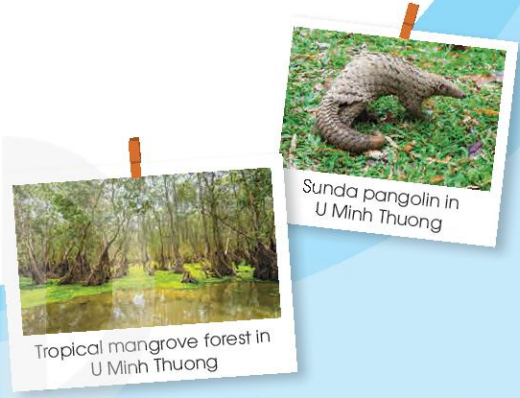Tiếng Anh 11 Unit 10 Reading1. Work in pairs. Look at the photos and discuss the questions. 2. Read the article and match the headings (1-4) to the paragraphs (A-D). 3. Read the article again and complete each sentence with no more than THREE words. 4. Work in groups. Discuss the following questions. GÓP Ý HAY - NHẬN NGAY QUÀ CHẤT Gửi góp ý cho HocTot.Nam.Name.Vn và nhận về những phần quà hấp dẫn
Lựa chọn câu để xem lời giải nhanh hơn
Bài 1 U Minh Thuong - A unique national park (U Minh Thượng – Vườn quốc gia độc đáo) 1. Work in pairs. Look at the photos and discuss the questions. (Làm việc theo cặp. Nhìn vào các bức ảnh và thảo luận các câu hỏi.) - Have you ever been to U Minh Thuong National Park? Where is it? (Bạn đã từng đến Vườn quốc gia U Minh Thượng chưa? Nó ở đâu?) - What can / did you see in the park? (Bạn có thể / đã nhìn thấy gì trong công viên?)
Lời giải chi tiết: A: Have you ever been to U Minh Thuong National Park? Where is it? (Bạn đã bao giờ đến Vườn quốc gia U Minh Thượng chưa? Nó ở đâu?) B: No, I haven't. Where is it located? (Không, tôi không có. Nó nằm ở đâu?) A: It's located in the southern part of Vietnam, in the Mekong Delta region. (Nó nằm ở phía nam của Việt Nam, trong khu vực đồng bằng sông Cửu Long.) B: Ah, I see. What can/did you see in the park? (À, tôi hiểu rồi. Bạn có thể/đã nhìn thấy gì trong công viên?) A: Well, I've seen some rare animals like otters and pangolins, and also many types of birds. The park is famous for its diverse ecosystems, including mangrove forests and wetlands. (Chà, tôi đã thấy một số loài động vật quý hiếm như rái cá và tê tê, và cũng có nhiều loại chim. Công viên nổi tiếng với hệ sinh thái đa dạng, bao gồm rừng ngập mặn và vùng đất ngập nước.) B: That sounds really interesting. I would love to visit the park someday and see those animals and ecosystems. (Điều đó nghe thật thú vị. Tôi rất thích đến thăm công viên vào một ngày nào đó và xem những loài động vật và hệ sinh thái đó.) Bài 2 2. Read the article and match the headings (1-4) to the paragraphs (A-D). (Đọc bài viết và nối các tiêu đề (1-4) với các đoạn văn (A-D).) 1. Flora and fauna (Hệ động thực vật) 2. Best time to visit (Thời gian tốt nhất để ghé thăm) 3. Location (Vị trí) 4. Geography (Địa lý) A. ____________________ U Minh Thuong National Park is located in An Bien, An Minh, and Vinh Thuan districts of Kien Giang Province, about 60 km south of Rach Gia city centre. This place is considered one of the most important sites for ecosystem conservation in the Mekong River Delta. It attracts tourists not only with its wild and beautiful scenery, but also with its rare and rich biodiversity. B. ____________________ U Minh Thuong National Park covers a large area of freshwater wetlands, including mangrove forests. Its central part is surrounded by waterways with a series of gates, which are used to manage the water level. C. ____________________ Home to 226 species of plants, U Minh Thuong National Park is the region with the richest biodiversity in the Mekong River Delta. It used to be one of the largest habitats for water birds in the area, but their home was badly damaged by forest fires in 2002. Now there are about two hundred types of birds in the park, including some unique birds like the great spotted eagle. Thirty-two types of mammals have been found here. Ten of them, including the fishing cat and Sunda pangolin, are on the list of rare and endangered species, native to Viet Nam. D. ____________________ The ideal time to explore U Minh Thuong National Park is from August to November, known as the floating water season of the region. Tourists can take a boat to experience nature and wildlife. Visitors can go to Trang Doi, a place where thousands of bats gather, hanging on the trees like huge fruits. Another popular place to visit is Trang Chim, a large area with thousands of colourful birds. So if you love nature, you should definitely go to explore this amazing natural park. Phương pháp giải: Tạm dịch: A. ____________________ Vườn quốc gia U Minh Thượng nằm trên địa bàn các huyện An Biên, An Minh và Vĩnh Thuận của tỉnh Kiên Giang, cách trung tâm thành phố Rạch Giá khoảng 60 km về phía Nam. Nơi đây được coi là một trong những địa điểm bảo tồn hệ sinh thái quan trọng nhất của vùng đồng bằng sông Cửu Long. Nơi đây hấp dẫn du khách không chỉ bởi khung cảnh hoang sơ, tươi đẹp mà còn bởi sự đa dạng sinh học phong phú hiếm có. B. ____________________ Vườn quốc gia U Minh Thượng bao phủ một vùng đất ngập nước ngọt rộng lớn, bao gồm cả rừng ngập mặn. Phần trung tâm của nó được bao quanh bởi các tuyến đường thủy với một loạt các cửa, được sử dụng để quản lý mực nước. C. ____________________ Là nơi cư trú của 226 loài thực vật, Vườn quốc gia U Minh Thượng là khu vực có đa dạng sinh học phong phú nhất ở đồng bằng sông Cửu Long. Nó từng là một trong những môi trường sống lớn nhất của các loài chim nước trong khu vực, nhưng ngôi nhà của chúng đã bị hư hại nặng nề do cháy rừng vào năm 2002. Hiện có khoảng hai trăm loài chim trong công viên, bao gồm một số loài chim độc đáo như đại bàng đốm lớn. . Ba mươi hai loại động vật có vú đã được tìm thấy ở đây. Mười loài trong số đó, bao gồm mèo chài và tê tê Sunda, nằm trong danh sách các loài quý hiếm có nguy cơ tuyệt chủng, bản địa của Việt Nam. D. ____________________ Thời điểm lý tưởng để khám phá vườn quốc gia U Minh Thượng là từ tháng 8 đến tháng 11, được mệnh danh là mùa nước nổi của vùng. Du khách có thể đi thuyền để trải nghiệm thiên nhiên và động vật hoang dã. Du khách có thể đến Trảng Dơi, nơi tập trung hàng nghìn con dơi, treo mình trên những ngọn cây như những trái khổng lồ. Một nơi phổ biến khác để tham quan là Trảng Chim, một khu vực rộng lớn với hàng ngàn loài chim đầy màu sắc. Vì vậy, nếu bạn yêu thích thiên nhiên, bạn chắc chắn nên đến khám phá công viên tự nhiên tuyệt vời này. Lời giải chi tiết: 1 - C. Flora and fauna (Hệ thực vật và động vật) 2 - D. Best time to visit (Thời gian tốt nhất để ghé thăm) 3 - A. Location (Vị trí) 4 - B. Geography (Địa lý) Bài 3 3. Read the article again and complete each sentence with no more than THREE words. (Đọc lại bài viết và hoàn thành mỗi câu với không quá BA từ.) 1. U Minh Thuong National Park is famous for its rare and rich ____________. 2. Waterways surround the ____________ of the national park. 3. It has more than two hundred ____________. 4. You can find nearly 200 types of birds and 32 ____________ there. 5. The best time to visit U Minh Thuong National Park is from _____________. Lời giải chi tiết:
1. U Minh Thuong National Park is famous for its rare and rich biodiversity. (Vườn quốc gia U Minh Thượng nổi tiếng với sự đa dạng sinh học quý hiếm và phong phú.) 2. Waterways surround the central part of the national park. (Các tuyến đường thủy bao quanh khu vực trung tâm của vườn quốc gia.) 3. It has more than two hundred species. (Nó có hơn hai trăm loài.) 4. You can find nearly 200 types of birds and 32 mammals there. (Bạn có thể tìm thấy gần 200 loại chim và 32 loài động vật có vú ở đó.) 5. The best time to visit U Minh Thuong National Park is from August to November. (Thời gian tốt nhất để tham quan Vườn quốc gia U Minh Thượng là từ tháng 8 đến tháng 11.) Bài 4 4. Work in groups. Discuss the following questions. (Làm việc nhóm. Thảo luận các câu hỏi sau.) Why do we need national parks? What should we do to protect them? (Tại sao chúng ta cần công viên quốc gia? Chúng ta cần làm gì để bảo vệ chúng?) Lời giải chi tiết: National Parks protect wildlife, habitats, and nature from destruction and human impact. They give animals a safe space to breed and survive. Over 247 species of threatened or endangered plants and animals are protected in National Parks. National parks protect places of natural beauty. National park is home to many endemic species. They also protect places important to Aboriginal people, and places that show how people lived in the past. National parks are actually protected areas. They protect many amazing animals and landscapes, such as the world's largest living things, Giant Sequoia trees, the longest cave system known to the world, Mammoth Cave National Park, and Crater Lake, America’s deepest lake etc. To protect national parks, some actions that can be taken include: Raising awareness: People need to understand the importance of national parks and the impact that their actions can have on them. Limiting human impact: National parks should be managed in a way that minimizes the impact of human activities such as logging, mining, and construction. Enforcing regulations: Rules and regulations should be in place to protect the parks, and these rules should be enforced to prevent illegal activities. Supporting park staff: Adequate resources should be provided to national parks and their staff to ensure that they can effectively manage and protect the parks. Educating visitors: Visitors should be educated about how to behave responsibly in national parks, such as avoiding littering, staying on marked trails, and not disturbing wildlife. Tạm dịch: Công viên quốc gia bảo vệ động vật hoang dã, môi trường sống và thiên nhiên khỏi sự tàn phá và tác động của con người. Họ cung cấp cho động vật một không gian an toàn để sinh sản và tồn tại. Hơn 247 loài thực vật và động vật bị đe dọa hoặc có nguy cơ tuyệt chủng được bảo vệ trong các Công viên Quốc gia. Vườn quốc gia bảo vệ những nơi có vẻ đẹp tự nhiên. Vườn quốc gia là nơi sinh sống của nhiều loài đặc hữu. Họ cũng bảo vệ những nơi quan trọng đối với thổ dân và những nơi cho thấy cách mọi người sống trong quá khứ. Vườn quốc gia thực sự là khu vực được bảo vệ. Chúng bảo vệ nhiều loài động vật và cảnh quan tuyệt vời, chẳng hạn như những sinh vật sống lớn nhất thế giới, cây Sequoia khổng lồ, hệ thống hang động dài nhất thế giới được biết đến, Công viên quốc gia hang động Mammoth và Hồ miệng núi lửa, hồ sâu nhất của Mỹ, v.v. Để bảo vệ các công viên quốc gia, một số hành động có thể được thực hiện bao gồm: Nâng cao nhận thức: Mọi người cần hiểu tầm quan trọng của các công viên quốc gia và tác động mà hành động của họ có thể gây ra cho họ. Hạn chế tác động của con người: Các vườn quốc gia nên được quản lý theo cách giảm thiểu tác động của các hoạt động của con người như khai thác gỗ, khai thác mỏ và xây dựng. Thực thi các quy định: Cần có các quy tắc và quy định để bảo vệ các công viên và những quy tắc này cần được thực thi để ngăn chặn các hoạt động bất hợp pháp. Hỗ trợ nhân viên công viên: Cần cung cấp đủ nguồn lực cho các công viên quốc gia và nhân viên của họ để đảm bảo rằng họ có thể quản lý và bảo vệ các công viên một cách hiệu quả. Giáo dục du khách: Du khách nên được giáo dục về cách cư xử có trách nhiệm trong các công viên quốc gia, chẳng hạn như tránh xả rác, đi trên những con đường mòn được đánh dấu và không làm phiền động vật hoang dã.
>> 2K9 Học trực tuyến - Định hướng luyện thi TN THPT, ĐGNL, ĐGTD ngay từ lớp 11 (Xem ngay) cùng thầy cô giáo giỏi trên Tuyensinh247.com. Bứt phá điểm 9,10 chỉ sau 3 tháng, tiếp cận sớm các kì thi.
|






















